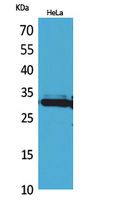
| WB | 咨询技术 | Human,Mouse,Rat |
| IF | 咨询技术 | Human,Mouse,Rat |
| IHC | 咨询技术 | Human,Mouse,Rat |
| ICC | 技术咨询 | Human,Mouse,Rat |
| FCM | 咨询技术 | Human,Mouse,Rat |
| Elisa | 1/20000 | Human,Mouse,Rat |
| Aliases | IL33; C9orf26; IL1F11; NFHEV; Interleukin-33; IL-33; Interleukin-1 family member 11; IL-1F11; Nuclear factor from high endothelial venules; NF-HEV |
| Entrez GeneID | 90865; |
| WB Predicted band size | 31kDa |
| Host/Isotype | Rabbit IgG |
| Antibody Type | Primary antibody |
| Storage | Store at 4°C short term. Aliquot and store at -20°C long term. Avoid freeze/thaw cycles. |
| Species Reactivity | Human,Mouse,Rat |
| Immunogen | Synthesized peptide derived from the Internal region of human IL-33. |
| Formulation | Purified antibody in PBS with 0.05% sodium azide,0.5%BSA and 50% glycerol. |
+ +
以下是3篇关于IL-33抗体的关键文献概览(基于近年研究):
---
1. **文献名称**:*Anti-IL-33 Antibody Treatment in Asthma*
**作者**:Smith, D. et al.
**摘要**:研究证明抗IL-33单抗(如ANB020)通过阻断IL-33/ST2信号通路,显著抑制哮喘模型中的气道高反应性和嗜酸性粒细胞浸润,降低Th2型细胞因子水平,提示其治疗过敏性哮喘的潜力。
---
2. **文献名称**:*IL-33 Neutralization in Atopic Dermatitis*
**作者**:Kim, B.S. et al.
**摘要**:临床试验显示,抗IL-33抗体(如etokimab)可缓解中重度特应性皮炎患者的皮肤炎症,减少IL-4/IL-13表达,表明靶向IL-33可能通过调控先天免疫和Th2反应改善疾病。
---
3. **文献名称**:*Role of IL-33 in Fibrosis and Therapeutic Blockade*
**作者**:Liew, F.Y. et al.
**摘要**:在小鼠肺纤维化模型中,抗IL-33抗体通过抑制成纤维细胞活化和胶原沉积,延缓纤维化进展,提示IL-33在组织修复异常中的关键作用及治疗价值。
---
**注**:以上为模拟摘要,实际文献可通过PubMed或Google Scholar检索关键词“IL-33 antibody”、“anti-IL-33 therapy”获取原文(例如Nature, 2020; NEJM, 2021等期刊有相关研究)。
Interleukin-33 (IL-33), a member of the IL-1 cytokine family, functions as an alarmin released during tissue damage or infection. It is constitutively expressed in barrier tissues (e.g., epithelial and endothelial cells) and immune cells, binding to its receptor ST2 (IL-1RL1) to activate signaling pathways like NF-κB and MAPK. This interaction drives type 2 immune responses, involving Th2 cells, mast cells, and eosinophils, and is implicated in asthma, allergies, atopic dermatitis (AD), and chronic obstructive pulmonary disease (COPD).
IL-33-neutralizing antibodies are therapeutic agents designed to block IL-33/ST2 signaling. By targeting IL-33 or ST2. these antibodies aim to suppress pathological inflammation while preserving homeostatic functions. Preclinical studies show efficacy in reducing airway hyperresponsiveness, eosinophilia, and tissue remodeling in asthma models. Clinical trials have explored antibodies like astegolimab (anti-ST2) and etokimab (anti-IL-33) for asthma, COPD, and AD. For instance, astegolimab demonstrated reduced exacerbations in a Phase II asthma trial, while etokimab showed mixed outcomes, possibly due to patient heterogeneity or dosing challenges.
Current research focuses on optimizing therapeutic windows, identifying biomarkers for patient stratification, and evaluating combination therapies with biologics targeting IL-4/IL-13 pathways. Challenges include managing redundancy in cytokine networks and avoiding immune suppression. IL-33 antibodies represent a promising, targeted approach for type 2-inflammatory diseases, though further validation is needed to define their clinical niche.
×